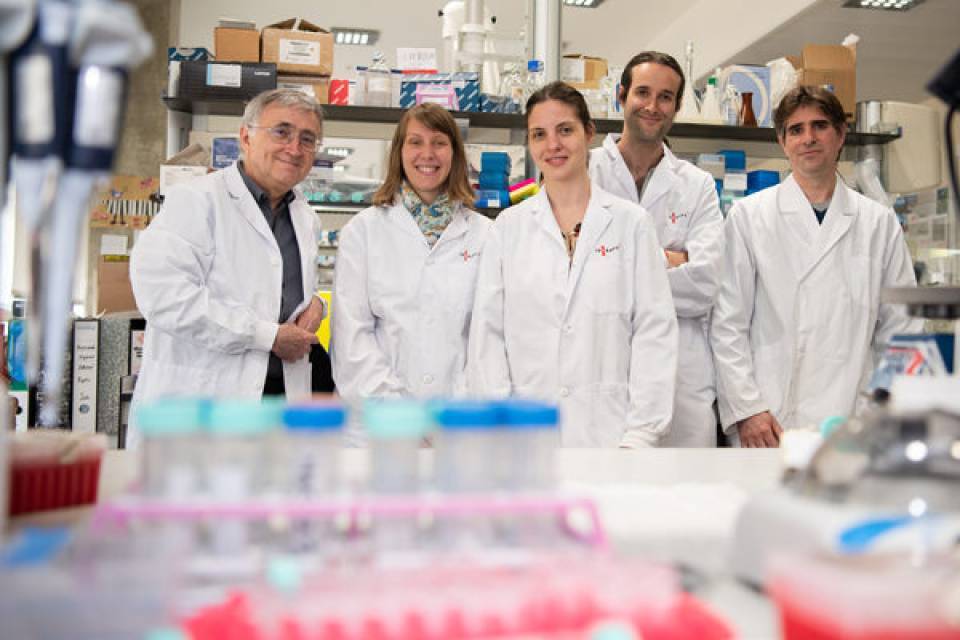The study has been led by Iñaki Martín-Subero, head of the Biomedical Epigenomics research group in IDIBAPS and UB lecturer, also member of the team led by Elias Campo, director of IDIBAPS, research director in Hospital Clínic and professor at the UB. The first signer of the article is Renée Beekman, researcher in the same group.
Over the last years, leukaemia molecular studies -and in other types of cancer- have focused on the molecular analysis with only one data layer, which provided a partial vision and did not allow researchers to create a precise map on the functions of the genome. “This study has no precedents in cancer genomic research and it emphasises the importance of bringing different molecular data layers for a better understanding of the illness”, says Elias Campo.
A map of the functioning of leukaemia genome
This group of researchers that have taken part in this study published, some years ago, the sequencing of the genome and methylome in leukaemia. This new study steps forward in the complete molecular description of the disease. Using state-of-the-art sequencing techniques and advanced computational biology tools, this study provides a detailed map of the functioning of the leukaemia genome. Iñaki Martín-Subero notes that “knowing the genome sequencing is not enough to know how it works; in order to know its functions and its regulation we need an analysis with multiple epigenetic layers”.
One of the biggest challenges is the computational analysis of big data. With the collaboration of the Barcelona Supercomputing Center (BSC-CNS), researchers could access the necessary high precision calculations to carry out this complex analysis. Renée Beekman says that “the most important challenge we had to face once the data was ready was to analyse and add so many data layers and to distil information that can help us to understand leukaemia better. It’s been three intense years of computer analysis to finally complete the functional map of leukaemia”.
Researchers could identify in detail those areas with specific functions. In particular, the dark areas of the genome, which were previously named junk DNA, lightened up, and they actually have many essential areas for the genome to work. According to Martin-Subero, “in a similar way to that of a geographical map, where there are urban areas, mountains, rivers, etc., we could map for the first time the complete map of the functions of the genome in leukaemia, defining active genes, inactive genes, areas without genes but which control the expression, big inactive deserts in the genome, among others. We identified a total of twelve different functions in the map of the genome”.
Three proteins, responsibles for the change
Apart from studying cells in leukaemia, researchers compared these to healthy cells. Renée Beekman states that “we could see how the leukaemia map changes compared to the healthy cell map, and how leukaemia are able to create an efficient molecular infrastructure to grow with no control. Metaphorically speaking, where there was a desert there are now industrial areas created by cancer cells”. Iñaki Martín-Subero adds that “we even found that only three protein families seem to be in charge of this change. In the lines of that metaphor, it’s as if three companies were in charge of building and maintaining all industrial areas”. This is an important aspefct in the study, since the action of these three families of proteins can be inhibited by drugs which are still under development. In this sense, Elias Campo notes that “this may be the most important translational aspect in the study, since it offers a therapeutic perspective through which functional alterations in leukaemia can be reverted”.
“This complete map allows us to understand leukaemia at a molecular level and it also offers a great source of information to other researchers, in order to translate findings into a better treatment and better life quality for the patients”, concludes Iñaki Martín-Subero.
The study was carried out within the context of the European Commission Blueprint for the study of the epigenome and the Spanish Chronic Lymphocytic Leukaemia Genome Consortium, in which a total of 51 researchers from twenty-three different institutions of six different countries have taken part.
Article reference:
The reference epigenome and regulatory chromatin landscape of chronic lymphocytic leukemia.
Renée Beekman, Vicente Chapaprieta, Núria Russiñol, Roser Vilarrasa-Blasi, Núria Verdaguer-Dot, Joost H. A. Martens, Martí Duran-Ferrer, Marta Kulis, François Serra, Biola M. Javierre, Steven W. Wingett, Guillem Clot, Ana C. Queirós, Giancarlo Castellano, Julie Blanc, Marta Gut, Angelika Merkel, Simon Heath, Anna Vlasova, Sebastian Ullrich, Emilio Palumbo, Anna Enjuanes, David Martín-García, Sílvia Beà, Magda Pinyol, Marta Aymerich, Romina Royo, Montserrat Puiggros, David Torrents, Avik Datta, Ernesto Lowy, Myrto Kostadima, Maša Roller, Laura Clarke, Paul Flicek, Xabier Agirre, Felipe Prosper, Tycho Baumann, Julio Delgado, Armando López-Guillermo, Peter Fraser, Marie-Laure Yaspo, Roderic Guigó, Reiner Siebert, Marc A. Martí-Renom, Xose S. Puente, Carlos López-Otín, Ivo Gut6, Hendrik G. Stunnenberg, Elias Campo and Jose I. Martin-Subero.

